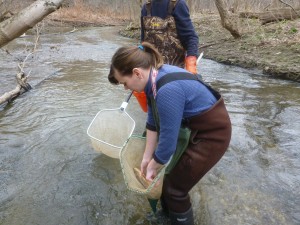It’s no joke—in many places, fish can’t get to the other side of a road. Listen up for the why and so what:

Allison Moody working in the Pike River, just north of Kenosha, WI (John Rodstrom)
Turns out, fish can’t just go with the flow after all. According to research out of the University of Wisconsin-Madison, more than 1,000 dams and 100,000 road crossings inhibit fish movement in the Great Lakes region. CurrentCast got the scoop from post-doc Allison Moody, a member of the research team that mapped it all out.
“Basically any fish that’s moving from the lakes up to the streams and rivers to breed can’t get up to a lot of the water,” she explains. “So they’re really restricted to habitat that’s really close to the lake.”
Moody and her team mapped out the barriers, and created an online tool that shows how much habitat can be gained if each is removed or made fish-friendly. Combined with invasive species data, this tool can help prioritize restoration dollars so they’re used most effectively.
Get schooled:
- Read more about the study in the Science Blog
- Check out FishWerks, the online mapping tool you can use to learn about barriers to fish movement in the Great Lakes region
The fine print:
- This segment was produced in partnership with Cornell’s Atkinson Center for a Sustainable Future




